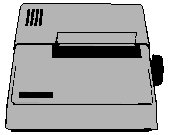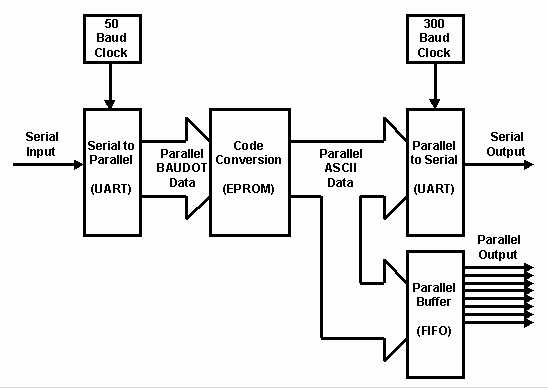Technical details
General Description
The Baudot to ASCII Converter accepts current loop baudot data from a WF44
radar and drives an ASCII serial or parallel printer. The units achieves this
by converting the current loop baudot data to parallel data, applies it as the
address to an eprom, which functions as a conversion table. The parallel data
out of the EPROM is used for the parallel printer output and also it is converted
to serial data for use by a serial printer.
The attached printer would only print each line of radar data after the radar
has sent a carriage return at the end of that line.
Construction
These units were assembled in commercial sheet metal cases. Each unit was
largely constructed in isolation as the need arose, meaning that they were very
much one off's.
A simple transformer, bridge diode, filter capacitor and TO220 regular based
power supply scheme was used, once again the layout and form of this section
was fairly fluid over the few unit manufactured.
Standard D-way connectors were used for the inputs and outputs to and from the
converter. A DB15S connector was used for the parallel printer output, DB25S
connector for the serial data output and a DB9S connector for the serial input
data connection from the parent radar.
Trendcom 100 Thermal Printer
 The
First printer used was the Trendcom model 100 thermal printer. It was a very
neat looking unit built in a buff coloured metal cabinet. This printer, instead
of using solenoids driving pins in a print head, used a thermal printer-head
but it needed a heat-sensitive paper. Their operation was very quiet, about
as loud as sliding your finger across a piece of paper. They were inexpensive
compared to other printers of the day (most of which cost over $1,000), although
the printing looked very much like that produced by a dot-matrix printer.
The
First printer used was the Trendcom model 100 thermal printer. It was a very
neat looking unit built in a buff coloured metal cabinet. This printer, instead
of using solenoids driving pins in a print head, used a thermal printer-head
but it needed a heat-sensitive paper. Their operation was very quiet, about
as loud as sliding your finger across a piece of paper. They were inexpensive
compared to other printers of the day (most of which cost over $1,000), although
the printing looked very much like that produced by a dot-matrix printer.
The Trendcom Model 100 printed 40 characters per line on paper that was about
4 1/2 inches wide and came in rolls 80 feet in length. The print colour was
black.
Circuit Detail
A National Semiconductor MM5303 universal asynchronous receiver/transmitter
(UART) converted the serial input data into parallel to feed the address lines
of a 2716 EPROM. This was programmed with the look-up table between baudot and
ASCII codes. The output data lines of the EPROM then fed a pair of 3341 FIFOs
(First In - First Out buffers) to provide a parallel data output to a parallel
printer. The same EPROM output lines are used as the parallel input to another
MM5303 UART whose serial output was clocked out at a 300 baud rate for a serial
connection.
Two 555 timer chips provided the input and output clock rates of 50 and 300
baud. The later also fed a diode voltage doubler to generate a neagitive 12v
supply for the output UART.
The Eprom address ranges were setup so that with an external toggle switch the
input Line Feed Baudot character could generate either two line feeds, line
feed/carriage return or two carriage returns - as required by the model of printer
used.
|
Block Diagram
|
 |
Input Data Format
The input data had to be in the following form:- 50 Baud, 5 Data bits, 1 1/2
stop bits and input as a 40mA current loop
Output Data Formats
The output data took the following forms:-
Parallel - 8 bit parallel data with negative going strobe pulses
Serial - 600 Baud, 8 bit, no parity, 2 stop bits, ASCII data
Problems, Faults, and their End
Experience showed that it was imperative that all seven teleprinter drive pulses
were the correct length and that the driving source was setup for single current
working. Most difficulties with the converter eventually were proven to be caused
by either of these being incorrect.
The units being such a simple circuit, rarely if ever failed and lasted until
better technology became available. So the Baudot to ASCII converters were eventually
replaced by the Radar Printer Interface as it was able to printout calculated
wind data.
BAUDOT TO ASCII CONVERTER
2516 EPROM PROGRAMMING FOR BAUDOT TO ASCII CONVERSION
Normal Operation - no letters
0000 - 001F Letters translated to Figures
0000 00 35
0D 39 20 24 2C 2E 0A 29 34 40 38 30 3A 3D
0010 33 2B 06 3F 21 36 25 2F 2D 32 07 81 37 31 28 82
0020 - 003F Figures
0020 00 35 0D 39 20 24 2C 2E 0A 29 34 40 38 30 3A 3D
0030 33 2B 06 3F 21 36 25 2F 2D 32 07 81 37 31 28 82
0100 - 011F Letters, normal
0100 00 54 0D 4F 20 48 4E 4D 0A 4C 52 47 49 50 43 56
0110 45 5A 44 42 53 59 46 58 41 57 4A 81 55 51 4B 82
0120 - 013F Figures, CR translated to LF
0120 00 35 0A 39 20 24 2C 2E 0A 29 34 40 38 30 3A 3D
0130 33 2B 06 3F 21 36 25 2F 2D 32 07 81 37 31 28 82